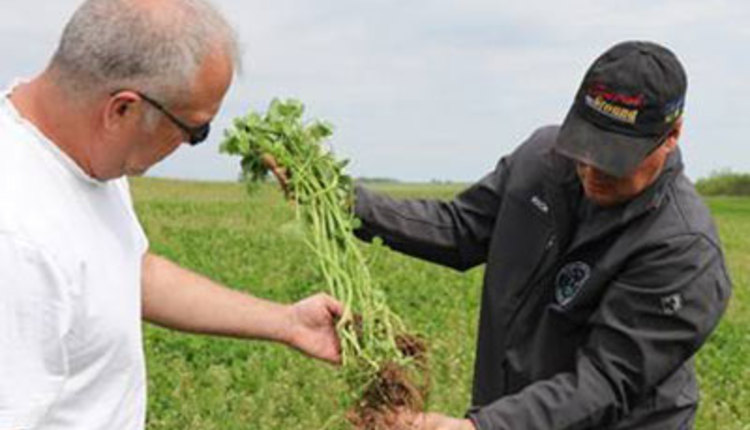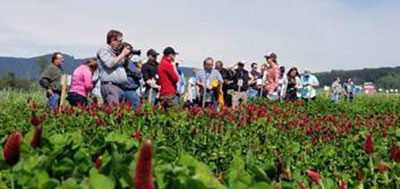Cover Crop Corner: Tapping into your cover crop resources |
|
Whether it be attending a local field day or reaching out to someone you’ve read about in an article, speaking directly to farmers utilizing cover crops is one of the most effective ways to expand your knowledge. |
Without a doubt, one of the best ways to progress is to learn from others. Here are a few resources to do that.This item has been supplied by a forage marketer and has not been edited, verified or endorsed by Hay & Forage Grower.From selecting the right cover crop variety to zeroing in on management practices, cover crops can be incredibly complex. However, to truly harness their full potential, it is essential to invest the time into learning more about them.  Whether it be attending a local field day or reaching out to someone you’ve read about in an article, speaking directly to farmers utilizing cover crops is one of the most effective ways to expand your knowledge. Here are a few resources worth tapping into to expand your cover crop knowledge: Expand your network A crucial first step is to expand the network of people you interact with. This opens huge opportunities to get new application ideas and to learn what has and hasn’t worked for other cover crop users. On a local level, look for regional field days to attend to engage with cover crop growers in your area. Chances are, they will have some of the same geographical challenges and can offer their solutions. It’s also worth looking into what regional Cover Crop Councils have to offer. Funded by the USDA NRCS and SARE, there are currently four (Midwest Cover Crop Council, Northeast Cover Crop Council, Southern Cover Crop Council and Western Cover Crop Council) that have online resources available to address the needs of their specific areas. Most of them hold annual conferences, detailing new research and management practices. If you’re able to go further afield, there are several fantastic national conferences each year chocked full of soil health experts and innovative farmers. Conferences like Soil Health U and No-Till on the Plains give attendants access to the most innovative knowledge while providing endless networking opportunities. Seek expert advice Speaking of learning from others, this doesn’t have to be limited to networking at events. Are there producers in your area that are notable for their expertise and data? Did you read an interesting article about a producer’s application practices and success? Did you see a Tweet or a Facebook post from someone sharing their practices? Reach out to them and pick their brain. From my experience, people tend to be more than happy to share their knowledge and can offer a lot of practical insight. There are also several professionals that offer their services for free. For example, your local seed supplier will have access to field trials and producers doing innovative things. There is also your local NRCS and Extension services who are there to provide you with advice, or access to those with the information you require. If you want a more tailored and one-on-one approach, you may need to be prepared to pay a small fee. There is an increasing number of local farmers with years of cover cropping experience starting their own consultancy practices to provide growers with hands-on advice. Certified Crop Advisors are also now a great resource with soil health and cover crop practices recently being included in their training. Go online While what you learn in person from fellow cover crop growers and experts carries a lot of weight, you can also tap into that knowledge online. Social media has also been a great tool to see how producers throughout the world are utilizing cover crops and to see what is and isn’t working. Pages like “Everything Cover Crops” and “Cover Crops and Soil Building” on Facebook have thousands of members from different parts of the world sharing practices and results every day. If you have questions about things like termination or what species work well to improve soil and feed grazing livestock, there are several people willing to share their insight. If you are looking for research or farm trial data to review, check out the recently launched Cover Crop Information Map. Found on gocovercrops.com and featuring an interactive map of the United States, users can narrow down available research and farm trial findings based on their geographical region and topic of interest. Organized into 26 different topic areas, which include inter-seeding, nutrient management and erosion control, users can easily find information. One of the best parts of the platform is linking to farm trial data. So, in a search about planting green, users can access raw data from research studies along with results from a farmer – allowing users to tailor findings and methods to their own unique system. Investing time into data Perhaps one of the most crucial parts to improving your cover crop practices is an investment into your own farm data to help with future decision making. Too often, farmers that I speak to that have been using cover crops for multiple years don’t have any data. Understanding what you’ve done in the past in order to build on successes and eliminate the possibility of repeating less successful tactics is critical to optimizing success and profitability. By sharing this data, whether it is on the Cover Crop Information Map platform, as a speaker at a regional open day or even just as you’re catching up with neighbors, the industry can make faster advancements by having more information to build on.  A great way to expand your network is to attend local field days. Not only does this allow you to see successful applications of different cover crops, but it also creates opportunities to learn from fellow producers in your area.
|
